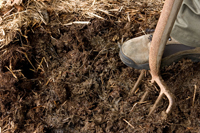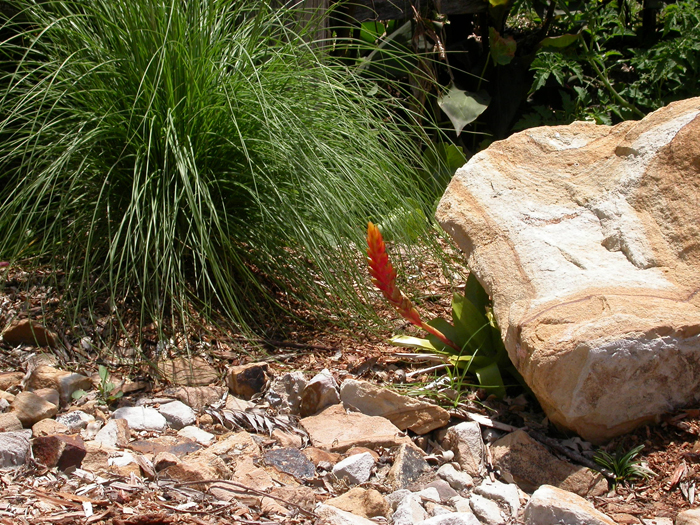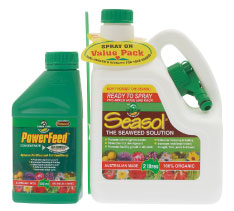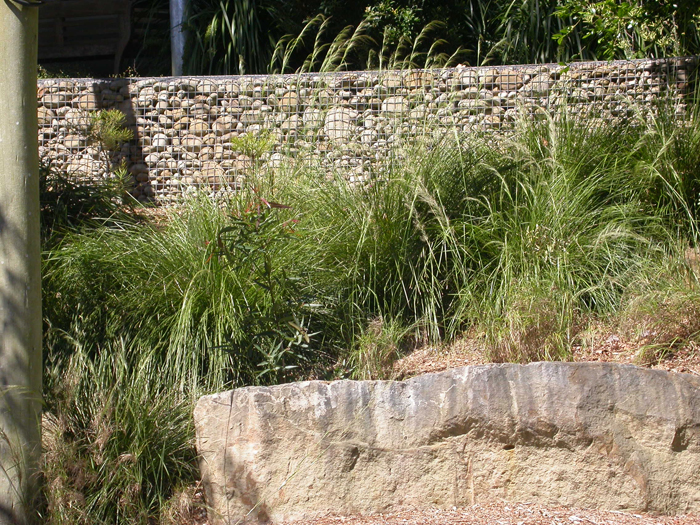
Lets talk fertilisers...
Fertiliser is the term used for concentrated forms of plant food. The same nutrients are contained in composts and manures but at lower concentrations. The advantage of manures and composts is that they also improve the texture of the soil in your garden. The advantage of fertilisers is that they are measurable, can be distributed more accurately and are faster acting.
What plants need

Plants need relatively large amounts of the major elements: Nitrogen (N), Phosphorus (P), Potassium (K), Calcium (Ca), Sulphur (S) and Magnesium (Mg). They also need only very small amounts of the trace elements that include: Iron (Fe), Manganese (Mn), Copper (Cu), Zinc (Zn), Boron (B), Molybdenum (Mo), Cobalt (Co) and Clorine (Cl). Be careful with the application of trace elements. Too much can be as damaging as not enough!
The advice of the CSIRO in regard to fertilisers is as follows:
"A sound strategy for fertiliser use in home gardens is to use concentrated fertilisers to overcome gross nutrient deficiencies but thereafter to conserve as many nutrients as possible and return them to our soils via compost heaps, and so use fertilisers only as required to supplement the nutrients supplied in our compost."
From "Food for Plants" by the CSIRO Division of Soils
When should you fertilise?
Gardens should be fertilised at the beginning of the growing season. Twice a year in spring and in autumn is a practice that ensures that all plants in the garden receive some supplementary fertiliser for their growth period.

Organic fertilisers such as Blood and Bone and Dynamic Lifter® give your soil long-term benefits with increased earthworm activity. However, they lack certain nutrients that are essential for plant growth that a "Complete Plant Food" type fertiliser will provide.
Liquid fertilisers such as Seasol® and Thrive® can be watered onto the soil around plants in the early morning or late afternoon to promote faster growth. Use these on a monthly basis to speed the development of stunted specimens.

Nutrients, plants and pH
The pH of a soil can have a significant effect on the availability of nutrients. Some nutrients can remain locked in the soil if the pH is too high or too low. Correcting the pH can often release these nutrients without the need for additional fertilisers.
Soils and nutrients
Clay soils tend to retain nutrients for long periods of time but the clay is often too hard for plant roots to penetrate. Sandy soils lose their nutrients very quickly through leaching (ie washing of nutrients down from the topsoil by rain and watering). In both cases, the problems can be reduced by the incorporation of organic matter such as composts and manures into the soil. Organic matter helps to break up clay soils and helps to bulk up sandy soils!
Native plants

Australian soils generally have low levels of Phosphorus. This is not a problem for native gardens because Australian plants have evolved in these soils and are able to thrive despite the low levels of Phosphorus. Native plant fertilisers are available which contain a suitable balance of N-P-K.
Exotic plants
Exotic species, vegetables and turf, however do require more Phosphorus than unimproved soil can provide. In many soils there is a chemical "hunger" for phosphorus and phosphate fertilisers need to be applied over a period of time before the "hunger" is satisfied and the additional phosphorus becomes available to the plants.
Fertilising lawns

Turf species have the same nutrient requirements as most exotic plants but, because lawns are continually mowed and the clippings removed, there is a net loss of nutrients that will need to be corrected if the lawn is to remain green and healthy. Applications of lawn food fertilisers are best every two months during the main growing season (ie September, December and February).
Nutrient deficiency
The leaves of plants will often reveal symptoms that indicate the deficiency of certain elements. However, the symptoms can be confusing to the average gardener. An experienced horticulturist should be consulted for a professional diagnosis of leaf discolouration or distortions.
Soil Texture
The soil provides anchorage for the plant as well as water, nutrients and temperature control. How well the soil provides its life-support functions to the plant depends largely on its fertility and its "texture" which is the term used to describe the range of soils between the extremes of sand and clay. Sandy soils have low fertility, are usually deficient in organic matter and do not retain water very well. Clay soils on the other hand are high in nutrients but tend to remain waterlogged after rain and impervious to rain when dry. Good gardening soil is somewhere near the middle of these extremes.
Clay Soil
Clay soils can be improved by the addition of gypsum to break up the clay into smaller particles and by mixing in composts and manures to help keep the smaller particles from sticking back together. In some areas, lime or phosphates may also be necessary but expert advice should be sought on this as soil characteristics vary from region to region in Australia.
Sandy Soil
Adding composts and manures to sandy soils helps to improve its water retention and provide nutrients but the effect is usually not permanent because the organic particles and nutrients are leached down through the soil by rain. Sandy soils will need to be kept well mulched and fertiliser added as necessary. Organic fertilisers such as blood and bone, manures and compost are preferable to chemical fertilisers that are quickly leached from the topsoil.
